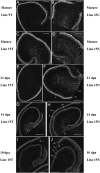Down-regulation of the CSLF6 gene results in decreased (1,3;1,4)-beta-D-glucan in endosperm of wheat
- PMID: 20089768
- PMCID: PMC2832239
- DOI: 10.1104/pp.109.151712
Down-regulation of the CSLF6 gene results in decreased (1,3;1,4)-beta-D-glucan in endosperm of wheat
Abstract
(1,3;1,4)-beta-d-Glucan (beta-glucan) accounts for 20% of the total cell walls in the starchy endosperm of wheat (Triticum aestivum) and is an important source of dietary fiber for human nutrition with potential health benefits. Bioinformatic and array analyses of gene expression profiles in developing caryopses identified the CELLULOSE SYNTHASE-LIKE F6 (CSLF6) gene as encoding a putative beta-glucan synthase. RNA interference constructs were therefore designed to down-regulate CSLF6 gene expression and expressed in transgenic wheat under the control of a starchy endosperm-specific HMW subunit gene promoter. Analysis of wholemeal flours using an enzyme-based kit and by high-performance anion-exchange chromatography after digestion with lichenase showed decreases in total beta-glucan of between 30% and 52% and between 36% and 53%, respectively, in five transgenic lines compared to three control lines. The content of water-extractable beta-glucan was also reduced by about 50% in the transgenic lines, and the M(r) distribution of the fraction was decreased from an average of 79 to 85 x 10(4) g/mol in the controls and 36 to 57 x 10(4) g/mol in the transgenics. Immunolocalization of beta-glucan in semithin sections of mature and developing grains confirmed that the impact of the transgene was confined to the starchy endosperm with little or no effect on the aleurone or outer layers of the grain. The results confirm that the CSLF6 gene of wheat encodes a beta-glucan synthase and indicate that transgenic manipulation can be used to enhance the health benefits of wheat products.
Figures







Similar articles
-
Expression analysis of cellulose synthase-like genes in durum wheat.Sci Rep. 2018 Oct 23;8(1):15675. doi: 10.1038/s41598-018-34013-6. Sci Rep. 2018. PMID: 30353138 Free PMC article.
-
Over-expression of specific HvCslF cellulose synthase-like genes in transgenic barley increases the levels of cell wall (1,3;1,4)-β-d-glucans and alters their fine structure.Plant Biotechnol J. 2011 Feb;9(2):117-35. doi: 10.1111/j.1467-7652.2010.00532.x. Plant Biotechnol J. 2011. PMID: 20497371
-
Introduction of glucan synthase into the cytosol in wheat endosperm causes massive maltose accumulation and represses starch synthesis.Plant J. 2021 Jun;106(5):1431-1442. doi: 10.1111/tpj.15246. Epub 2021 May 4. Plant J. 2021. PMID: 33764607
-
Down-regulation of Glucan, Water-Dikinase activity in wheat endosperm increases vegetative biomass and yield.Plant Biotechnol J. 2012 Sep;10(7):871-82. doi: 10.1111/j.1467-7652.2012.00711.x. Epub 2012 Jun 6. Plant Biotechnol J. 2012. PMID: 22672098
-
Wheat amino acid transporters highly expressed in grain cells regulate amino acid accumulation in grain.PLoS One. 2021 Feb 19;16(2):e0246763. doi: 10.1371/journal.pone.0246763. eCollection 2021. PLoS One. 2021. PMID: 33606697 Free PMC article.
Cited by
-
Transitions in wheat endosperm metabolism upon transcriptional induction of oil accumulation by oat endosperm WRINKLED1.BMC Plant Biol. 2020 May 25;20(1):235. doi: 10.1186/s12870-020-02438-9. BMC Plant Biol. 2020. PMID: 32450804 Free PMC article.
-
Cell wall degradation is required for normal starch mobilisation in barley endosperm.Sci Rep. 2016 Sep 13;6:33215. doi: 10.1038/srep33215. Sci Rep. 2016. PMID: 27622597 Free PMC article.
-
Enzymes in 3D: Synthesis, remodelling, and hydrolysis of cell wall (1,3;1,4)-β-glucans.Plant Physiol. 2023 Dec 30;194(1):33-50. doi: 10.1093/plphys/kiad415. Plant Physiol. 2023. PMID: 37594400 Free PMC article.
-
The impact of the SSIIa null mutations on grain traits and composition in durum wheat.Breed Sci. 2016 Sep;66(4):572-579. doi: 10.1270/jsbbs.16025. Epub 2016 Jul 21. Breed Sci. 2016. PMID: 27795682 Free PMC article.
-
Temporal and spatial changes in cell wall composition in developing grains of wheat cv. Hereward.Planta. 2010 Aug;232(3):677-89. doi: 10.1007/s00425-010-1199-5. Epub 2010 Jun 13. Planta. 2010. PMID: 20549231
References
-
- Anonymous (2008) Final Rule on Soluble Fiber from Certain Foods and Risk of Coronary Heart Disease (73 FR 47828). U.S. Food and Drug Administration, College Park, MD - PubMed
-
- Bacic A, Stone BA. (1980) A (1→3)- and (1→4)-linked β-D-glucan in the endosperm cell walls of wheat. Carbohydr Res 82: 372–387
-
- Bacic A, Stone BA. (1981) Chemistry and organisation of aleurone cell wall components from wheat and barley. Aust J Plant Physiol 8: 475–495
-
- Bamforth CW. (1982) Barley β-glucans: their role in malting and brewing. Brewers Digest 57: 22–27
-
- Bechtel D, Wilson JD. (2003) Amyloplast formation and starch granule development in hard red winter wheat. Cereal Chem 80: 175–183
Publication types
MeSH terms
Substances
Grants and funding
LinkOut - more resources
Full Text Sources
Other Literature Sources

